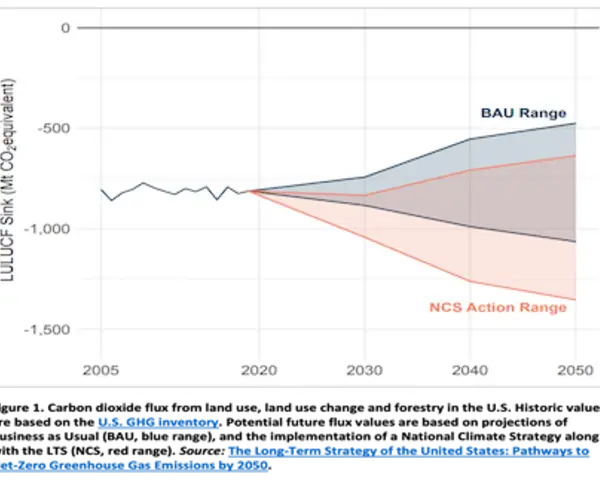The Land Carbon Sink in the U.S. Long Term Strategy: Six Things You Should Know

Justin Baker
Associate Professor, Forest Resource Economics, NC State University
The Biden Administration recently published the Long Term Strategy of the United States, outlining different pathways the nation can take to reduce greenhouse gas (GHG) emissions to net-zero by 2050.
The U.S. has committed to reducing GHG emissions by 50-52% below 2005 levels by 2030, and to achieving net-zero emissions by 2050. These commitments are in-line with the levels of mitigation scientists say are needed to avoid dangerous effects of climate change.
The Long Term Strategy (LTS) provides a roadmap for how the nation will meet this net-zero goal by 2050. Important steps in this roadmap include decarbonizing the electricity system, electrifying the transportation sector, improving energy system efficiency, and reducing non-CO2 greenhouse gases from industry and agriculture.
Another key component of the LTS roadmap will be the strengthening of the land carbon sink, which in 2019 offset more than 12% of economy-wide emissions, via absorption of carbon in plant biomass and soils. The activities referenced in the LTS to enhance the land carbon sink include protecting, expanding, and improving the management of forest lands, preventing forest fires, planting trees in urban and agricultural lands, and scaling up climate-smart agriculture practices.
The LTS projects that the land sink could remove an additional 100-300 million tons of CO2 from the atmosphere annually by mid-century. Here are six more things you should know about the potential role of the land carbon sink in the LTS:

Mitigation potential is estimated as a range using multiple models. The projection of mitigation potential from the land carbon sink in the LTS (the red range in Figure 1) is based on the results from multiple economic models of the U.S. forestry and land use system. Most of these models reflect economic opportunity costs of mitigation investments (e.g., reduced revenues from deferred or delayed harvests). Using multiple models better represents variation in mitigation estimates due to a range of different approaches and assumptions, such as differences in spatial coverage (global vs. national), time scale, and inclusion of different product markets. The projected range represents model differences, outcomes from alternative socioeconomic assumptions, and the net effect of different policy incentives (e.g., mitigation prices) on carbon storage.
Read the full Long Term Strategy to learn more about how the U.S. can achieve its goal of net-zero emissions by 2025.
Interested in learning more about our work in climate resilience, mitigation, and adaptation? Visit our Center for Climate Solutions.